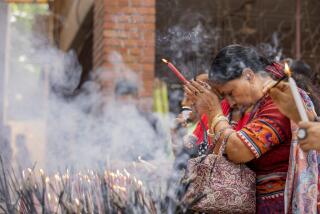L.A.-area Hindus celebrate the new year
- Share via
Shivani Shodhan is busy with her graduate studies in public health in Virginia, but she was back home in Southern California Sunday for an event she didn’t want to miss with her family: the celebration of the Hindu New Year and Festival of Lights.
Shodhan, a 21-year-old from Canoga Park, was one of the thousands of Hindus in Southern California who gathered at homes and in temples for the occasion. By the Hindu tradition that Shodhan’s family observes, Sunday was the fourth day of Diwali -- the Festival of Lights -- and the day that rings in the lunar new year, 2063.
“The entire community comes together on this auspicious day and we get to celebrate the light, we get to celebrate good over evil and we get to do that together, in unity,” Shodhan said. “Everybody is just full of hope, because it’s our new year.”
It is a time for visiting, exchanging gifts, decorating homes, setting off fireworks and wearing new clothes. Gambling is encouraged as a way of ensuring good luck.
Shodhan, clad in sky-blue traditional Indian dress, joined her parents at the Valley Hindu Temple in Northridge, one of the largest meeting centers for Hindus in Southern California. For many, the temple is both a social and religious facility, where Hindus from different parts of the world come together.
Hinduism is thousands of years old and the world’s third-largest religion, behind Christianity and Islam. Adherents who gathered at the temple Sunday represented some of Hinduism’s thousands of sects, which generally consider the Veda to be their most sacred scripture and absolute authority.
The array of statues of deities in the temple “represent different manifestations of the same power,” said Bal Sarad of Granada Hills, a vice president with the temple and the owner of a textile business. “Our message is ‘Just believe in him, and it doesn’t matter which shape or form you worship.’ ”
People in different regions of India celebrate the Diwali season in various ways, but the lighting of small earthenware oil lamps is widespread, symbolic of the victory of light over evil and ignorance.
The scene in Northridge was characteristic of Hindu practice. In the early afternoon, a leader chanted in Hindi and Sanskrit, and the congregants, many of them immigrants from India, at various points recited lines, clapped or chatted quietly with friends. The attendees, all barefoot or in stockings, were seated on the floor.
Old friends greeted one another with such expressions as naya Saal Mubarak, which means happy new year or happy Diwali.
On one side were statues representing deities, bedecked with colorful garlands.
In front were dishes featuring about 200 Indian delicacies -- foods brought as an offering to Krishna but also meant for visitors to enjoy. They were a crucial part of the day’s Annkut, or “heap of grains,” ceremony. The offerings were intended to bring about divine assurance that food would never be exhausted and that people would be blessed with peace, happiness and prosperity.
“Everybody brings something, sweet, sour, spicy. Whatever they can do,” said Shodhan’s mother, Bhavna Shodhan, who brought thaal, a collection of vegetarian treats made with such items as potatoes, eggplant, rice, chiles and yogurt. Her daughter added: “You offer the best you can offer.”
Mitula Patel, a chief financial officer with an insurance brokerage who lives in Woodland Hills, said she invited non-Hindu friends to join her for the celebration. “My friends are coming just for the food,” she said, laughing.
Still, what matters most to Patel, she said, is that, in the Hindu community, it’s “one time that we leave everything -- all of our work and everything -- and get together.”
More to Read
Sign up for Essential California
The most important California stories and recommendations in your inbox every morning.
You may occasionally receive promotional content from the Los Angeles Times.










